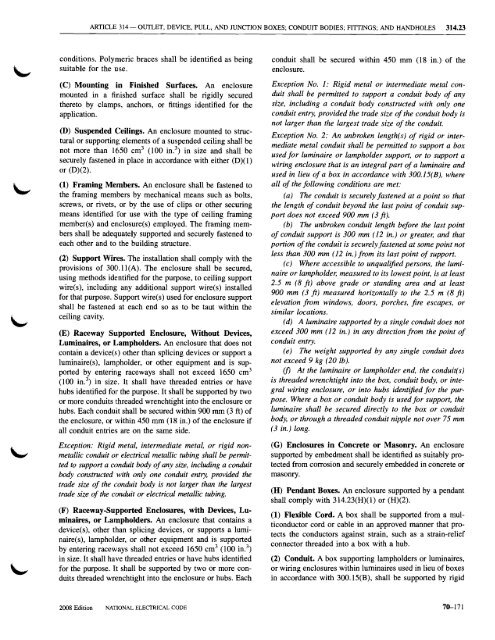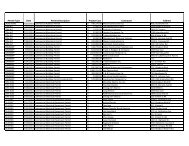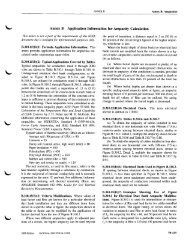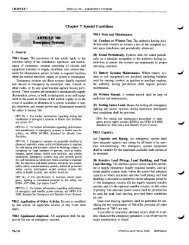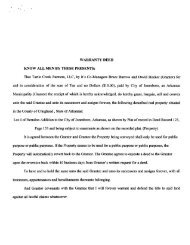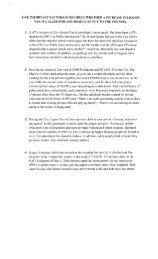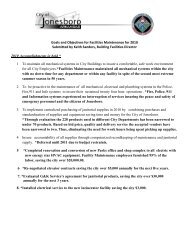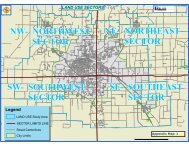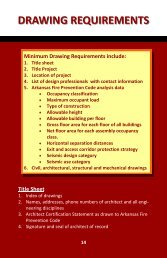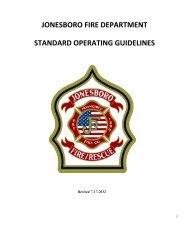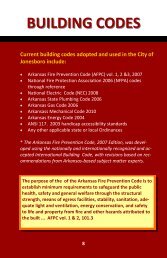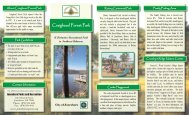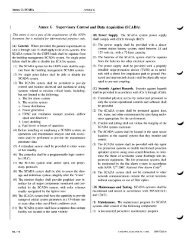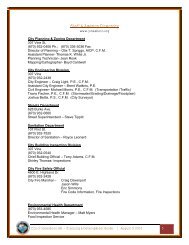Chapter 3 Wiring Methods and Materials
Chapter 3 Wiring Methods and Materials
Chapter 3 Wiring Methods and Materials
You also want an ePaper? Increase the reach of your titles
YUMPU automatically turns print PDFs into web optimized ePapers that Google loves.
ARTICLE 314-0UTLET, DEVICE, PULL, AND JUNCTION BOXES; CONDUIT BODIES; FITIINGS; AND HANDHOLES 314.23<br />
conditions. Polymeric braces shall be identified as being<br />
suitable for the use.<br />
(C) Mounting in Finished Surfaces. An enclosure<br />
mounted in a finished surface shall be rigidly secured<br />
thereto by clamps, anchors, or fittings identified for the<br />
application.<br />
(D) Suspended Ceilings. An enclosure mounted to structural<br />
or supporting elements of a suspended ceiling shall be<br />
not more than 1650 cm 3 (100 in?) in size <strong>and</strong> shall be<br />
securely fastened in place in accordance with either (D)(1)<br />
or (D)(2).<br />
(1) Framing Members. An enclosure shall be fastened to<br />
the framing members by mechanical means such as bolts,<br />
screws, or rivets, or by the use of clips or other securing<br />
means identified for use with the type of ceiling framing<br />
member(s) <strong>and</strong> enclosure(s) employed. The framing members<br />
shall be adequately supported <strong>and</strong> securely fastened to<br />
each other <strong>and</strong> to the building structure.<br />
(2) Support Wires. The installation shall comply with the<br />
provisions of 300.11 (A). The enclosure shall be secured,<br />
using methods identified for the purpose, to ceiling support<br />
wire(s), including any additional support wire(s) installed<br />
for that purpose. Support wire(s) used for enclosure support<br />
shall be fastened at each end so as to be taut within the<br />
ceiling cavity.<br />
(E) Raceway Supported Enclosure, Without Devices,<br />
Luminaires, or Lampholders. An enclosure that does not<br />
contain a device(s) other than splicing devices or support a<br />
luminaire(s), lampholder, or other equipment <strong>and</strong> is supported<br />
by entering raceways shall not exceed 1650 cm 3<br />
(100 in. 3 ) in size. It shall have threaded entries or have<br />
hubs identified for the purpose. It shall be supported by two<br />
or more conduits Ithreaded wrenchtight into the enclosure or<br />
hubs. Each conduit shall be secured within 900 mm (3 ft) of<br />
the enclosure, or within 450 mm (18 in.) of the enclosure if<br />
all conduit entries are on the same side.<br />
Exception: Rigid metal, intermediate metal, or rigid nonmetallic<br />
conduit or electrical metallic tubing shall be permitted<br />
to support a conduit body ofany size, including a conduit<br />
body constructed with only one conduit entry, provided the<br />
trade size of the conduit body is not larger than the largest<br />
trade size of the conduit or electrical metallic tubing.<br />
(F) Raceway-Supported Enclosures, with Devices, Luminaires,<br />
or Lampholders. An enclosure that contains a<br />
device(s), other than splicing devices, or supports a lurninaire(s),<br />
lampholder, or other equipment <strong>and</strong> is supported<br />
by entering raceways shall not exceed 1650 cm 3 (100 in. 3 )<br />
in size. It shall have threaded entries or have hubs identified<br />
for the purpose. It shall be supported by two or more conduits<br />
threaded wrenchtight into the enclosure or hubs. Each<br />
conduit shall be secured within 450 mm (18 in.) of the<br />
enclosure.<br />
Exception No.1: Rigid metal or intermediate metal conduit<br />
shall be permitted to support a conduit body of any<br />
size, including a conduit body constructed with only one<br />
conduit entry, provided the trade size of the conduit body is<br />
not larger than the largest trade size of the conduit.<br />
Exception No.2: An unbroken length(s) of rigid or intermediate<br />
metal conduit shall be permitted to support a box<br />
used for luminaire or lampholder support, or to support a<br />
wiring enclosure that is an integral part of a luminaire <strong>and</strong><br />
used in lieu of a box in accordance with 300.15(B), where<br />
all of the following conditions are met:<br />
(a) The conduit is securely fastened at a point so that<br />
the length of conduit beyond the last point of conduit support<br />
does not exceed 900 mm (3 ft).<br />
(b) The unbroken conduit length before the last point<br />
of conduit support is 300 mm (12 in.) or greater, <strong>and</strong> that<br />
portion ofthe conduit is securely fastent~d at some point not<br />
less than 300 mm (12 in.) from its last point of support.<br />
(c) Where accessible to unqualified persons, the luminaire<br />
or lampholder, measured to its lowest point, is at least<br />
2.5 m (8 ft) above grade or st<strong>and</strong>ing area <strong>and</strong> at least<br />
900 mm (3 ft) measured horizontally to the 2.5 m (8 ft)<br />
elevation from windows, doors, porches, fire escapes, or<br />
similar locations.<br />
(d) A luminaire supported by a single conduit does not<br />
exceed 300 mm (12 in.) in any direction from the point of<br />
conduit entry.<br />
(e) The weight supported by any single conduit does<br />
not exceed 9 kg (20 lb).<br />
(f) At the luminaire or lampholder end, the conduit(s)<br />
is threaded wrenchtight into the box, conduit body, or integral<br />
wiring enclosure, or into hubs identified for the purpose.<br />
Where a box or conduit body is used for support, the<br />
luminaire shall be secured directly to the box or conduit<br />
body, or through a threaded conduit nipple not over 75 mm<br />
(3 in.) long.<br />
(G) Enclosures in Concrete or Masonry. An enclosure<br />
supported by embedment shall be identified as suitably protected<br />
from corrosion <strong>and</strong> securely embedded in concrete or<br />
masonry.<br />
(H) Pendant Boxes. An enclosure supported by a pendant<br />
shall comply with 314.23(H)(l) or (H)(2).<br />
(1) Flexible Cord. A box shall be supported from a multiconductor<br />
cord or cable in an approved manner that protects<br />
the conductors against strain, such as a strain-relief<br />
connector threaded into a box with a hub.<br />
(2) Conduit. A box supporting lampholders or luminaires,<br />
or wiring enclosures within luminaires used in lieu of boxes<br />
in accordance with 300.15(B), shall be supported by rigid<br />
2008 Edition NATIONAL ELECTRICAL CODE 70-171


